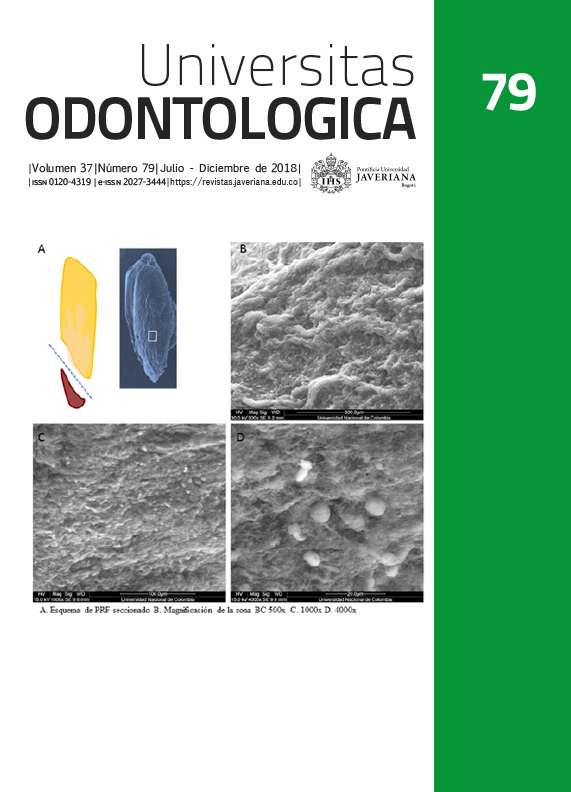Abstract
Background: Sjögren’s syndrome is an autoimmune disease that manifests after the age of 45 years and whose incidence increases with age. Symptoms in the oral cavity includes dry mouth or xerostomia. Large number of Sjögren’s patients wear complete dentures due to tooth loss at advanced ages. Objective: To describe the case of a Sjögren’s patient for whom dentures with salivary reservoirs were made to reduce oral symptoms. Methods: Lab tests were conducted to find an optimum denture design with reservoirs. Requirements included: structural resistance, easy placement and removal of reservoir caps to allow cleaning, good esthetics, and containing the greatest amount of artificial saliva. Models were tried in the patient. Results: Several models were tried for both jaws. At the end, the patient reported about easiness to remove caps, absence of nausea, normal phonetics, adequate hygiene, comfort, and partial solution to the problem of xerostomia with an approximate duration of three hours once the reservoir was full. Conclusion: Final prototypes provided the best characteristics of reservoirs and stored the highest amounts of saliva. It is important to conduct clinical controlled trials to confirm the findings of this case.
Vitali C, Bombardieri S, Moutsopoulos HM, et al. Preliminary criteria for the classification of Sjögren’s Syndrome. Results of a prospective concerted action supported the European Community. Arthritis Rheumatism. 1993; 36(3): 340-8.
Shiboski SC, Shiboski CH, Criswell LA, et al. American College of Rheumatology classification criteria for Sjögren’s Syndrome: A data-driven, expert consensus approach in the Sjögren’s International Collaborative Clinical Alliance Cohort. Arthritis Care Res. 2012; 64(4): 475-87.
Wolff S, Ofer M, Raviv, et al. The flow rate of whole and submandibular/sublingual gland saliva in patients receiving replacement complete dentures. J Oral Rehab. 2004; 340-3.
Närhi TO, Meurman JH, Ainamo A. Xerostomia and hyposalivation: causes, consequences and treatment in the elderly. Drugs Aging. 1999; 15: 103-16.
Greenspan. Xerostomia: diagnosis and management. Oncol. 1996; 10: 7-11.
Gótrickl S, Akerman D, Ericson, et al. oral Pilocarpine for treatment of opioid-induced oral dryness in healthy adults. J Dent Res. 2004; 83(5): 393-7.
Dawidson B. Angmar-Mánsson M, Blom, et al. Sensory stimulation (acupuncture) increases the release of vasoactive intestinal polypeptide in the saliva of xerostomia sufferers. Neuropeptides. 1998; 32(6): 543-8.
Davies AN. A comparison of artificial saliva and chewing gum in the management of xerostomia in patients with advances cancer. Palliat Med. 2000; (14): 197-203.
Ilzarbe LM, Ilazarbe LM Jr, Villar D. Piercing canalizado, microirrigadores CIQ e implante hueco transfixivo para tratamiento de la xerostomía grave. Gaceta Dental: Industria y Profesiones. 2006; (169): 112-32.
Vergo JT, Kadish P. Dentures as artificial saliva reservoirs in the irradiated edentulous cancer patient with xerostomia: A pilot study. Oral Surg. 1981; 51(3): 229-33.
Vissink A, Gravenmade EJ, Panders AK, et al. Artificial saliva reservoirs. J Prosthet Dent. 1984 Nov; 52: 710-5.
Toljanic JA, Zucuskie TG. Use of a palatal reservoir in denture patients with xerostomia J Prosthet Dent. 1984; 52: 540-4.
Vissink, MC Huisman, EJ Gravenmade. Construction of an artificial saliva reservoir in an existing maxillary denture. J Prosthet Dent. 1986; 56: 70-4.
Sinclair GF, Frost PM, Walter JD. New design for an artificial saliva reservoir for the mandibular complete denture. J Prosthetic Dent. 1996; 75: 276-80.
Frost PM, Gardner RM, Price AR et al. A preliminary assessment of intra-oral lubricating systems for dry mouth patients. Gerodontol. 1997; 14(1): 54-8.
Mendoza AR, Tomlinson MJ. The split denture: a new technique for artificial saliva reservoirs in mandibular dentures, Aust Dent J. 2003; 48: 190-4.
This journal is registered under a Creative Commons Attribution 4.0 International Public License. Thus, this work may be reproduced, distributed, and publicly shared in digital format, as long as the names of the authors and Pontificia Universidad Javeriana are acknowledged. Others are allowed to quote, adapt, transform, auto-archive, republish, and create based on this material, for any purpose (even commercial ones), provided the authorship is duly acknowledged, a link to the original work is provided, and it is specified if changes have been made. Pontificia Universidad Javeriana does not hold the rights of published works and the authors are solely responsible for the contents of their works; they keep the moral, intellectual, privacy, and publicity rights.
Approving the intervention of the work (review, copy-editing, translation, layout) and the following outreach, are granted through an use license and not through an assignment of rights. This means the journal and Pontificia Universidad Javeriana cannot be held responsible for any ethical malpractice by the authors. As a consequence of the protection granted by the use license, the journal is not required to publish recantations or modify information already published, unless the errata stems from the editorial management process. Publishing contents in this journal does not generate royalties for contributors.



